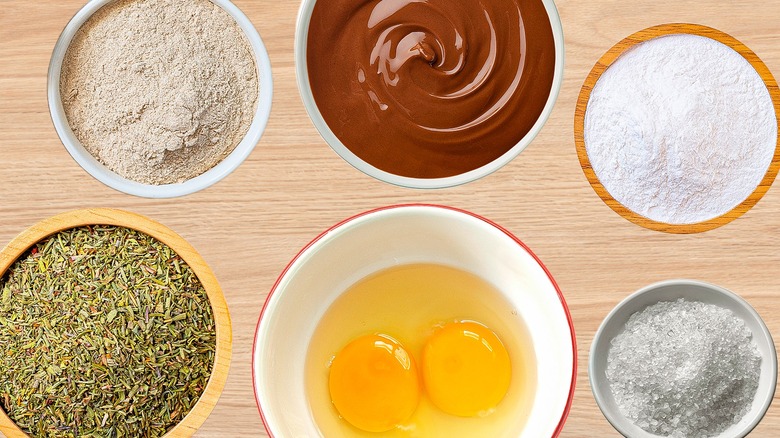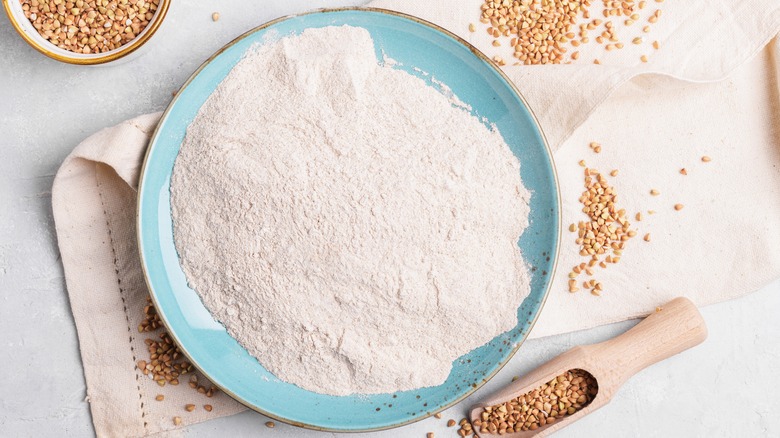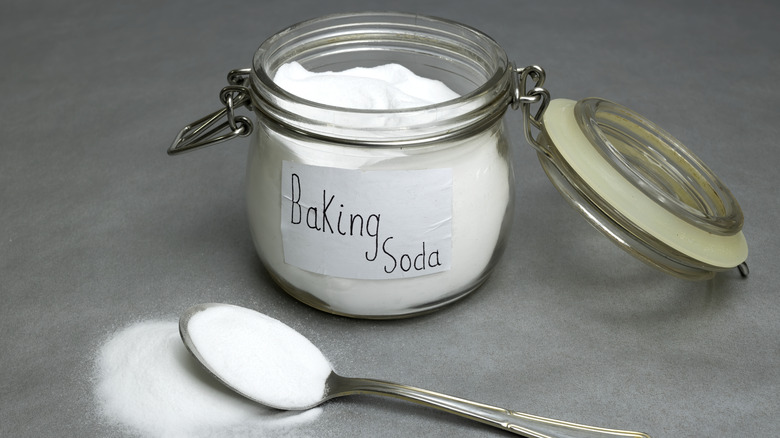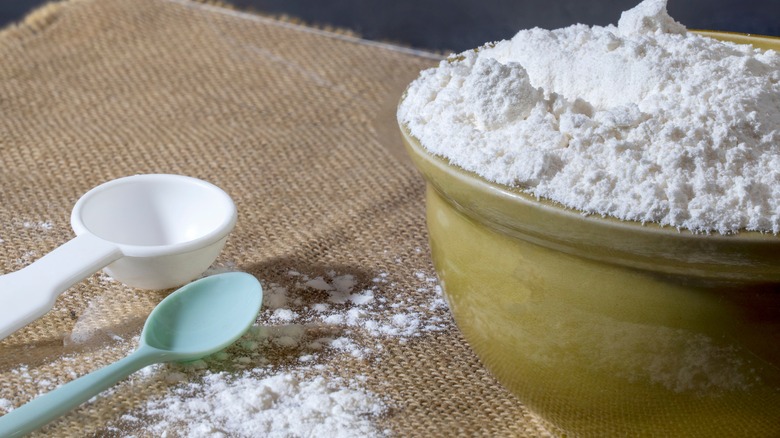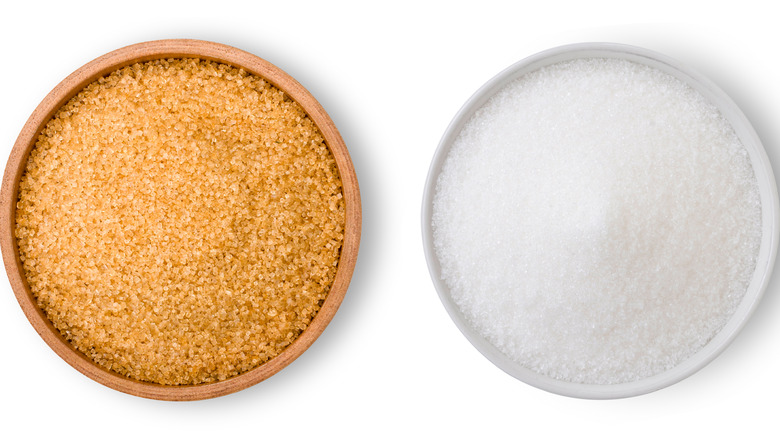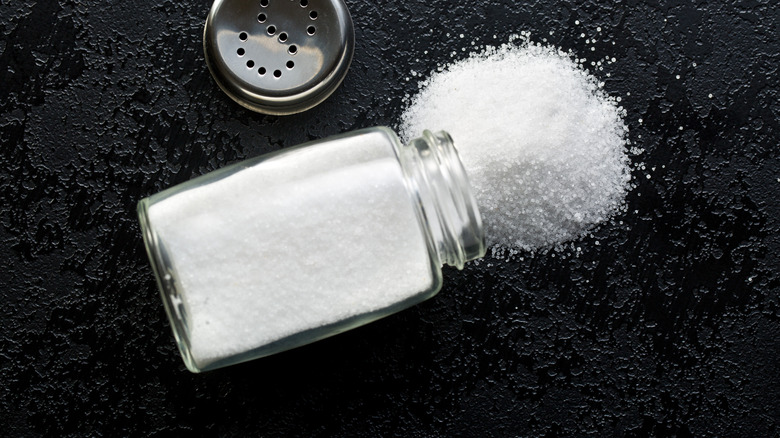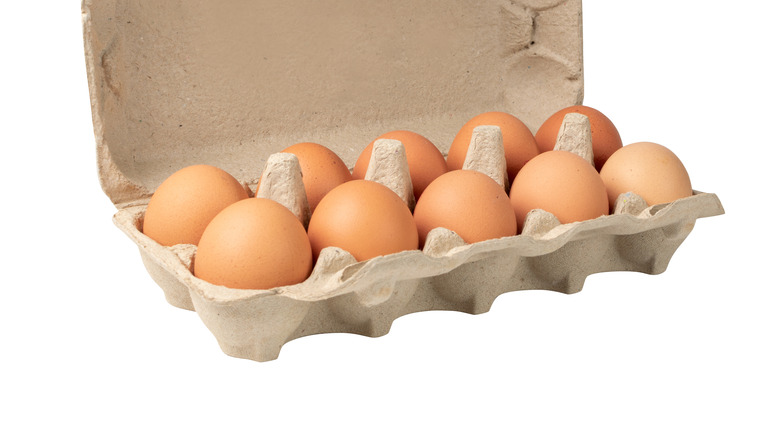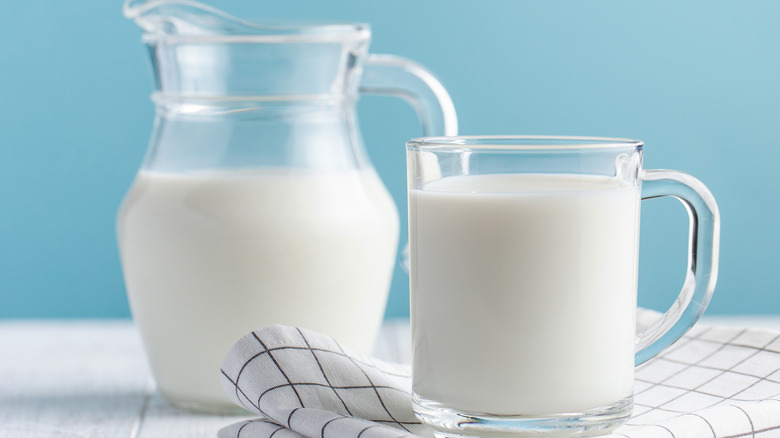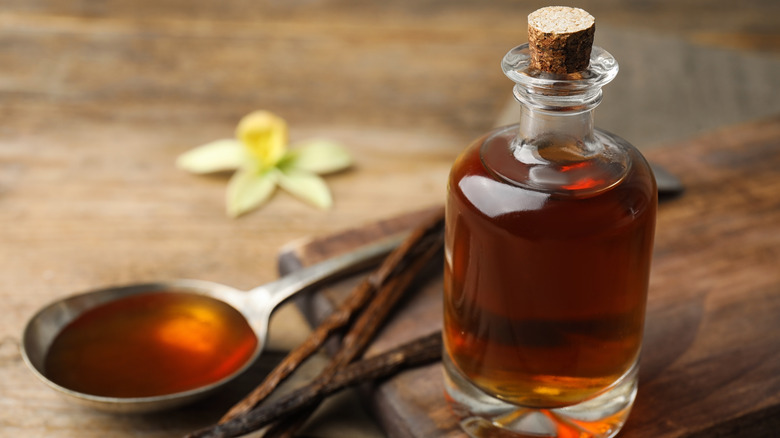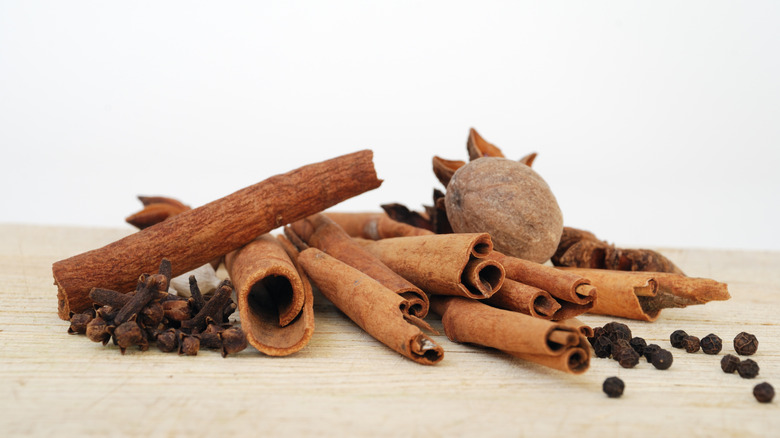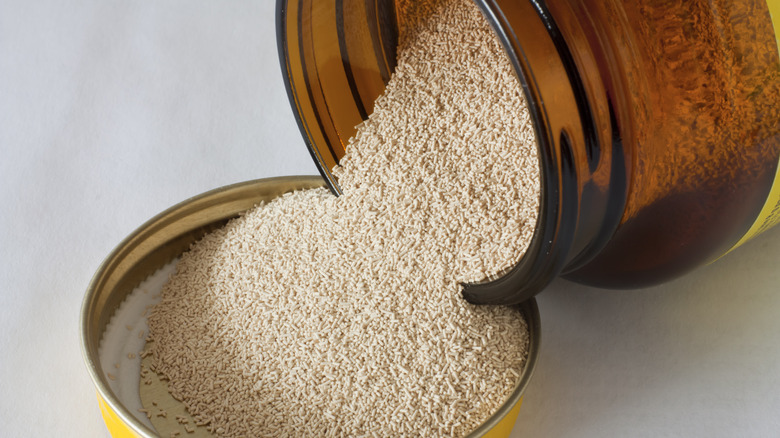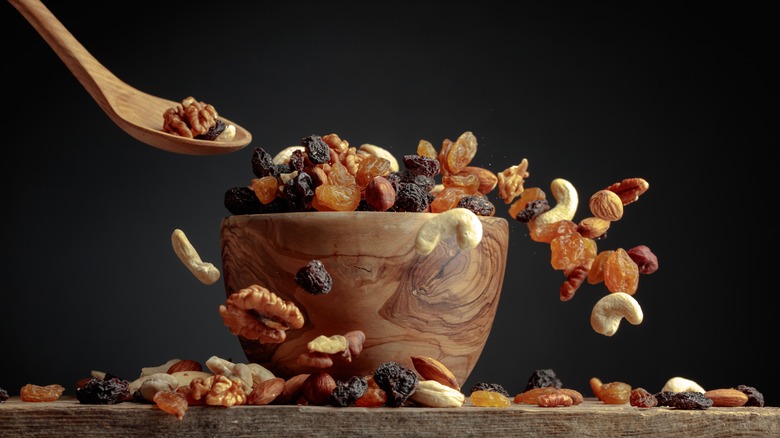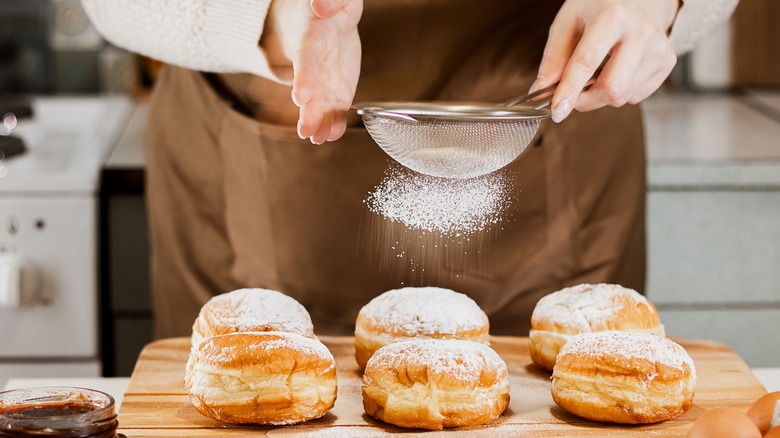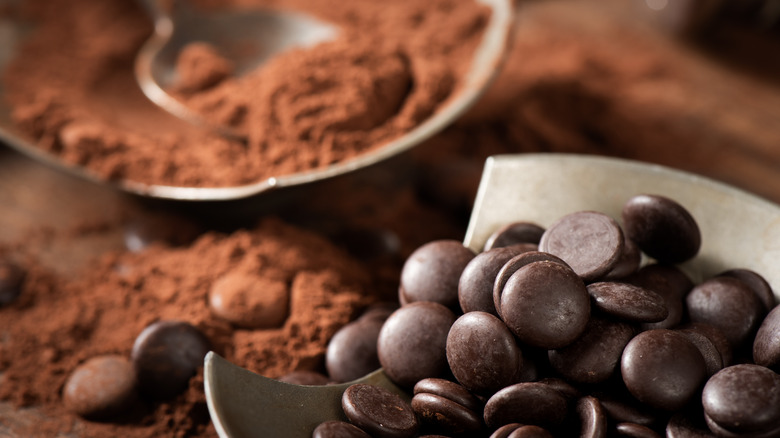14 Ingredients Every Baker Should Always Have On Hand
Just as there are essential tools every kitchen must have, so too are there requisite ingredients that should always be kept in a baker's pantry. These crucial ingredients form the building blocks of everyday baking for treats such as muffins, brownies, cookies, and bread. If you're serious about baking, you should always have these vital ingredients in stock so you never have to make a last-minute grocery store run or discard a half-made batch of cookies.
A well-stocked baking pantry helps you work more efficiently in the kitchen. But unfortunately, many of us have to deal with limited pantry space, so it can be challenging to figure out which ingredients are really needed and which are not. Whether you're new to baking, doing a bit of spring cleaning, or just taking stock of what's in your cupboard, here's a peek into our pantry to help guide you in your ventures.
1. Flour
Flour is the main (and largest) ingredient in many recipes for baked goods, and that's why it tops our list of essential ingredients every baker should always have on hand. You can choose to stock all sorts of flours, but all-purpose flour is the most widely used in baking as it is superbly versatile. Made from a mix of soft and hard wheat, all-purpose flour can make everything from flaky pie crusts and chewy cookies to tender cakes and fluffy pancakes. Store all-purpose flour in an airtight container in a cool, dark place for up to six months and away from smelly foods (like onions). You can also store flour in the freezer for a longer shelf life.
Depending on what you're baking, you may want to stock flours in addition to all-purpose. For example, if you frequently bake cakes, you may prefer to keep cake flour, which produces a soft and tender crumb. Or if chewy, crusty pizza doughs are your specialty, you should consider stocking bread flour. If pies and biscuits are your jam, stock pastry flour instead. Further, if you're avoiding gluten, you may need to keep gluten-free flours, like buckwheat, almond, or cassava.
2. Baking soda
Leaveners give baked goods their volume and airiness — without them, your baked treats will be dense with an unappetizing texture. One important leavener to always have in your pantry is baking soda, also called sodium bicarbonate. Baking soda has a high pH, meaning it is a base. When used in a recipe, baking soda reacts with an acid in the recipe (think buttermilk, yogurt, vinegar, etc.) to produce carbon dioxide in the form of tiny gas bubbles that allow baked goods to rise. If there is no acid (or not enough) in the recipe, the baked good won't rise well and will likely have an unpleasant metallic aftertaste due to the unneutralized baking soda.
If you run out of baking soda, you can, in a pinch, substitute it with baking powder. Baking soda is strong — about three times more than baking powder. So, if a recipe calls for ¼ teaspoon of baking soda, replace it with ¾ teaspoon of baking powder.
3. Baking powder
Another leavener you should always have on hand is baking powder. It is comprised of baking soda (a base), cream of tartar (an acid), and cornstarch (a buffer). If you are developing a recipe and baking powder is your only leavener, you don't need to add acid, as the baking powder comes pre-mixed with an acidic component.
Unlike baking soda, which reacts one time with an acid, baking powder is double-acting, meaning it acts twice to leaven your baked goods. The first leavening occurs when the baking powder is mixed with a liquid, like when mixing dry and wet ingredients in a muffin recipe. The second leavening occurs when the baking powder is exposed to heat, as when you place muffin batter in the oven to bake.
If you run out of baking powder, you can make your own by sifting together two parts cream of tartar with one part baking soda and one part cornstarch. For example, if a recipe calls for 1 teaspoon of baking powder, substitute it with ½ teaspoon of cream of tartar, ¼ teaspoon of baking soda, and ¼ teaspoon of cornstarch.
4. Sugar
White sugar is a crucial baking ingredient that should be a mainstay in your pantry. Referred to in recipes as "sugar," white sugar is the most common type of sweetener used in baking. Made from either sugar cane or sugar beets, white sugar moistens baked goods and contributes to browning (via the Maillard reaction), all while adding sweetness. Further, in recipes made with the creaming method, white sugar blends with butter (fat) to act as a leavener, ensuring your baked goods have lift and volume.
It's smart to also stock brown sugar, which is essentially white sugar that has been blended with molasses for a softer texture and more distinct flavor. Brown sugar adds dark color, caramel flavor, and moisture to baked goods. Brown sugar is available either light or dark — the difference lies in the amount of molasses used to make them. Dark brown sugar is made with more molasses than light brown sugar and has a darker color and deeper concentration of caramel flavor. Since you can use light and dark brown sugars interchangeably in recipes, which one to stock will depend on your taste preferences.
You should store sugar in an airtight container in a cool, dry location. Avoid the refrigerator for storing sugar, as moisture will turn sugar hard and clumpy. When stored properly, sugar can last for years. (Sweet!)
5. Salt
Salt plays multiple important roles in baking. First and foremost, salt is a flavor enhancer — without it, your baked goods will taste flat and one-dimensional. Salt also balances sweetness, taking your baked goods from mediocre to outstanding with just a pinch. And because salt is hygroscopic, it draws moisture into baked goods, keeping them fresher for longer and better tasting.
Many types of salts are available, but table salt is the one you'll want to stock in your baking pantry if you have to choose just one. Table salt consists of tiny, uniformly shaped crystals that are easy to measure consistently and dissolve more quickly and evenly into batters. If you have room in your pantry to spare, having a finishing salt within arm's reach is excellent for adding a distinctive flavor and satisfying crunch to your baked goods (especially chocolate chip cookies). Maldon, a flaky sea salt harvested in its namesake English town, is beloved by chefs and home cooks for its superior clean taste and unique pyramid-shaped crystals.
6. Eggs
Eggs are an incredibly versatile ingredient that plays many roles, depending on what you are making. The function of eggs in baking can include everything from stabilizing cakes and flavoring baked goods to binding custards, lightening batters, and leavening pastries. And since an egg is made up of about 74% water, it is also a good source of moisture. Eggs can even act as a glue or glaze when made into an egg wash.
The standard egg size used in baking is large. So, unless otherwise specified, you should use large eggs for baking to ensure your results are as the recipe developer intended. Because of an egg's natural protective seal known as a bloom or cuticle, you can store eggs at cool room temperature, but for safer, longer storage, it's best to store them in the refrigerator. Just make sure to bring your eggs to room temperature before baking with them for the best results.
7. Fats
Fats make baked goods tender, flavorful, and moist. Baked goods made with fat taste better, which is a baker's ultimate goal. When it comes to deciding which fats to stock in your pantry, there are two types to choose from: solid and liquid.
A reliable, all-purpose solid fat is shortening, also called hydrogenated vegetable oil (such as Crisco). Shortening is 100% fat, made from vegetable oils, like soybean, cottonseed, or palm oil. Shortening is ideal for making pie crusts because it stays solid at room temperature and has a high melting point, which makes the dough easy to work with. When used to make cakes or cookies with the creaming method, shortening traps air molecules well, resulting in an end product that rises loftier, holds its shape better, and has a lighter texture. And when used to make frostings, shortening stays firm, unlike butter which can melt and separate in warm temperatures.
Liquid fat includes any oil. Two popular (and affordable) oils are vegetable and canola. They are both neutral in flavor, which makes them great for baking because they allow the other ingredients to shine. But you also have other options when it comes to liquid fat. Some bakers swear by olive oil for its fruity taste and heart-healthy benefits, while some prefer coconut oil for its aromatic flavor that pairs well with bananas and chocolate for a hint of tropical taste. Oils vary in price, which may determine which one to stock in your pantry.
8. Dairy
While milk isn't called for in every recipe, having a small carton in the refrigerator when needed is convenient. Opt for whole milk because its higher fat content will add more flavor and moisture to your baked goods. Some bakers also store evaporated milk in their pantry since it's shelf stable and can easily be reconstituted into milk by adding an equal amount of water. If you're avoiding cow's milk, there are a slew of non-dairy alternatives — and many are shelf-stable, which is a win-win. Popular dairy-free choices include almond, oat, and soy milks.
For many bakers, buttermilk is their secret weapon. Not only does buttermilk provide a wonderful tangy flavor, but it also adds tenderness from fat and contributes to leavening by acting with baking soda. If you must choose between stocking buttermilk or milk, go with the latter because you can quickly turn milk into buttermilk. Simply stir 1 tablespoon of lemon juice or white vinegar into ½ cup of whole milk, and allow it to sit for 15 minutes to curdle before using.
If you have room in your fridge for more dairy, consider stocking sour cream, which adds incredible moistness and flavor to coffee cakes, cheesecakes, and pancakes, in addition to heavy cream, essential for making whipped cream, ganache, and caramel sauce.
9. Flavorings
While the flavorings you choose to keep in your baking pantry will come down to your taste buds, we recommend always keeping one specific extract: vanilla. A pantry staple, vanilla extract provides warm, floral notes to baked goods while enhancing the flavor of the other ingredients. Because vanilla makes a huge difference in your baking, don't buy diluted, imitation products, as they are made from a manufactured flavor component derived from petroleum. Lastly, since bottles of flavoring extracts don't occupy much space, you can keep other extracts in your favorite flavors, like rum, almond, lemon, and mint.
Consider stocking whole vanilla beans in your pantry if you frequently make desserts such as crème brûlée, jams, ice creams, and frostings. These long pods of the vanilla orchid are incredibly aromatic and add more intense flavor than the extract while providing attractive black specks. Since vanilla beans are on the pricier side, use them judiciously in desserts, but try to use them within a few weeks of purchase so they don't dry out.
10. Spices
Spices add enticing flavors to baked goods. Lucky for us, there are many wonderful spices to choose from. The most popular spice, by far, that every baker keeps in their pantry is cinnamon. Used in classic American desserts like apple pie, snickerdoodles, and sticky buns, cinnamon adds a sweet and spicy citrusy punch with warm, woody notes. If you love baking, you'll likely want to keep additional holiday and autumn spices in your pantry, like nutmeg, ginger, and cloves. Choose some of your other favorite spices to round out your collection if space permits.
We should note that while it's more convenient to buy spices in ground form, these products can fade in flavor and quickly turn dull. For the freshest flavor, buy whole spices and grind them in a mortar and pestle (or a spice grinder) right before using. You can even toast the whole spices before grinding for a more distinct flavor.
Pro tip: Not all cinnamon is created equal. If you want the highest quality cinnamon, look for the Ceylon variety. This cinnamon comes from the Ceylon tree native to Sri Lanka.
11. Yeast
If you enjoy baking yeast-risen bread or sweets (think pizza, bagels, cinnamon rolls, donuts, you get it), then you'll always want yeast in your pantry. Yeast is a single-cell living organism that needs food and moisture to thrive. When combined with sugar (food) and liquid (moisture), yeast converts the sugar to alcohol and carbon dioxide via fermentation. The carbon dioxide acts as a leavening agent to make doughs rise, while the fermentation provides the trademark flavor and texture of yeasted products.
Yeast is sold either fresh or dry. Because fresh yeast has a limited shelf life and most recipes are written for dry yeast, we recommend stocking your pantry with active dry or instant (rapid-rise) yeast. These two types of dry yeast can be used interchangeably in recipes, though they differ in their rate of action. Instant yeast acts quicker, so doughs with this yeast typically rise faster.
Since dry yeast is dormant when purchased, it can be stored at room temperature for up to two years from its packaged date. Once open, store dry yeast in an airtight container in the refrigerator or freezer.
12. Add-ins
For many bakers, nuts are a go-to add-in — and for good reason. Nuts provide nutrition and visual appeal while adding a wholesome crunch. Adding walnuts to brownies and pecans to carrot cake makes them more delicious and exciting. Like nuts, seeds improve aesthetics while contributing texture and a healthful halo to baked goods. Sunflower, pumpkin, poppy, and flax seeds — all are excellent choices. Lastly, consider stocking an assortment of dried fruit — like raisins, dried apricots, and dates. Dried fruits have an appealing chewy texture and a punch of concentrated flavor that many baked goods benefit from.
Nuts, seeds, and dried fruits should be stored in an airtight container. Keep nuts and seeds in the refrigerator or freezer to extend their shelf life; dried fruits can be stored at room temperature. If your dried fruit is accidentally exposed to air for an extended time and becomes stiff, steep it in warm liquid (e.g., water or liquor) to rehydrate before using it in a recipe.
13. Powdered sugar
A baker's pantry would be incomplete without powdered sugar. Also known as confectioners' or icing sugar, powdered sugar is made by grinding granulated sugar into a powdery, ultra-fine state, then mixing it with some cornstarch to prevent clumping. Bakers cherish powdered sugar because it dissolves seamlessly in sweet glazes, luscious buttercreams, and royal icing. Powdered sugar is especially good for making whipped cream because the small amount of cornstarch in it adds lift and stabilizes the end product. For quick decoration, you can sprinkle a light dusting of powdered sugar over desserts to prettify and sweeten them for a finishing touch.
You can make powdered sugar at home by grinding 1 cup of granulated sugar with 1 tablespoon of cornstarch in a high-powered blender or food processor until the mixture turns white and powdery, about a minute or two. Sift to remove large particles, and store the powdered sugar in an airtight container in a cool, dry place.
14. Chocolate
Chocolate comes in many forms. Deciding which to stock in your pantry can be challenging, especially if you're new to baking. So, we've narrowed the list to four forms of chocolate to always keep on hand: bar chocolate, chocolate chips, natural cocoa powder, and Dutch-process cocoa powder.
Bar chocolate is ideal for chopping or melting and incorporating into recipes for mousse, ice cream, sauce, ganache, or even making chocolate garnishes. Chocolate chips are a popular add-in for cookies and brownies and make delightful decorations.
Cocoa powder comes in two forms: natural and Dutch-processed. Natural cocoa powder is the type most found at grocery stores and is considered the default ingredient when recipes call for "cocoa powder." Since natural cocoa powder is acidic, recipes made with natural cocoa are typically leavened with baking soda.
On the other hand, Dutch-processed cocoa powder is neutral, having been washed with an alkaline solution to reduce its acidity, mellow its chocolate flavor, and darken its color. Recipes made with Dutch-process cocoa will typically call for baking powder. Using the wrong cocoa powder can result in dismal results like a collapsed cake or soapy-tasting brownies with a gummy texture, so having both types on hand will set you up for success.
